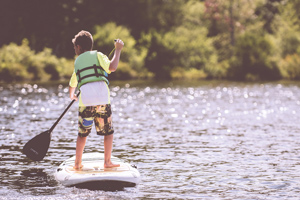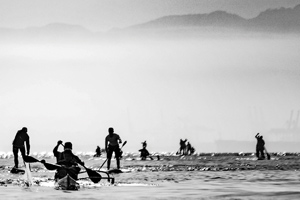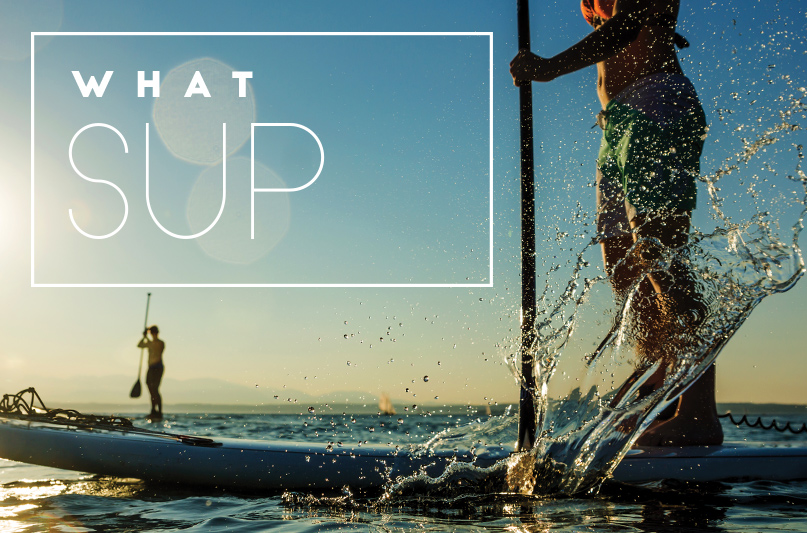
 These buoyant recreational watercrafts are here to stay as one of the fastest-growing sports in America and are a perfect complement to the Pacific Northwest boating lifestyle.
These buoyant recreational watercrafts are here to stay as one of the fastest-growing sports in America and are a perfect complement to the Pacific Northwest boating lifestyle.
There’s a lot to love about SUPs, especially as complements to a boating trip. Their highly-versatile nature makes them great adventure companions, and because they rely solely on human power, the environmental noise and fuel consumption impact is non-existent.
What’s more, the many customizable mounts for hard boards and the capabilities of inflatables make for easy on-board stowability. From fitness and yoga to racing and fishing, there are many ways to experience the water aboard a SUP. They are also low-maintenance and cost-effective once acquired. Today, SUPers have formed their own community with numerous clubs, groups, and social events.
SUPs are a boatload of fun, but it’s important to be safe and responsible before paddling out. They are still watercraft and it’s crucial to be familiar with the basic rules of the road and boating courtesy. Also, the performance limitations of paddleboards and physical fatigue of users are elements to be taken seriously. Combating high winds or strong tides can be difficult, and it’s easy to find oneself in a dangerous situation if not prepared.
We offer our thoughts and the insight of local SUP guru Rob Casey, owner of Salmon Bay Paddle, to help give both aspiring and seasoned SUPers information on SUP culture, boards, accessories, rentals, uses, and more to help get you one stroke closer to a super SUP summer.
Two basic, popular SUP families exist: inflatable and hard boards. Before you float one way or the other, take a moment to identify your lifestyle. Knowing your lifestyle is key to picking the board that’s right for you.
Are you a liveaboard with limited space? Do you find yourself without a car? Are you drawn to raging rivers? Then an inflatable may be your calling. Their lightweight design and deflation capabilities make them easily transferrable and storable, especially in Seattle where condo-dwellers, houseboat owners, and other small spaces are more common. They’re also better alternatives for whitewater paddling and for yoga due to their softer nature. For most general purposes, they’re a great option for recreational day use.
However, according to Casey, “If you’re looking to advance in the paddling sport or want to rip it up like Kelly Slater with full-on surfing techniques, the high-performing hard boards are the way to go.” Hard boards generally offer more versatility and additional opportunities where inflatables falter.
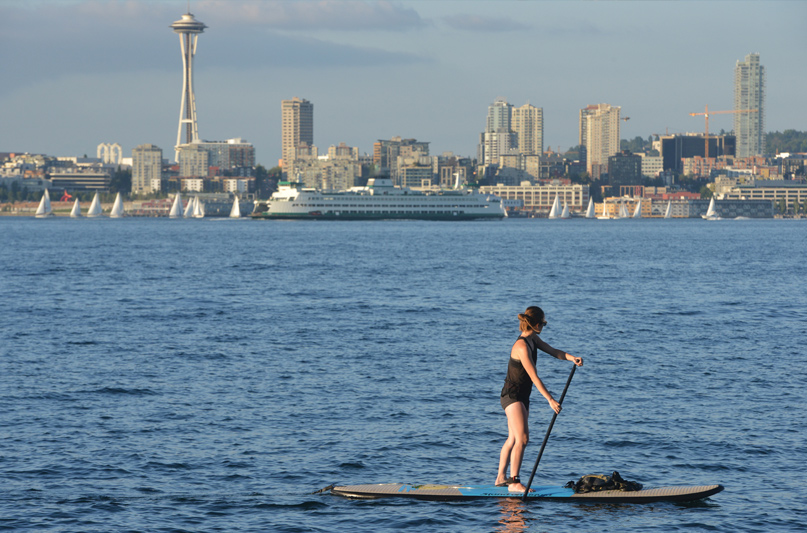
“Hard board” is a broad term used to describe every board except inflatables. These include epoxy, carbon fiber, plastic (rotomolded), hybrid, and wood. Their rigid nature is great for long distance paddling because even with constant improvements to inflatables’ rigidity, they will always have that minor flex. With hard boards, more rigidity means less drag, more speed, and greater agility with less effort. Because hard boards are also available in a larger variety of sizes and finely-tuned shapes, it’s easier to find one that fits you just right. But to find your perfect board, it’s important to identify your desired uses.
Touring-, racing-, fishing-, yoga-, fitness-, and river-specific SUPs are the most common SUP makes; each activity requires slightly different characteristics for the ultimate efficiency. Only after you settle on a SUP lifestyle can you then drill down the details of your perfect board. Hull type, volume, weight, length, and width come into play when choosing your ideal option.
Most boards feature either planing or displacement hulls. To be more precise, bow is the correct term because every paddleboard has a flat hull – it’s the bow that changes from board to board. Planing bows are flat, wide, and resemble that of a surfboard’s. They’re perfect for leisure paddling, yoga, and beginners; as well as taking on whitewater rapids. Displacement hulls have a pointed bow that’s ideal for fitness, racing, and touring.
Volume and weight capacity are also vital when choosing a SUP. To get the most out of your board it must displace the correct amount of water for your weight. Combined, these two factors determine stability. Bow type also comes into play here. If you’re below the weight capacity of a planing nose board, you’re good to go, but with a displacement hull, if your weight exceeds what the board can handle, you’ll sink into the water. If you’re too light, the board will feel too heavy and uncontrollable.
Next, settle for a length. For an everyday board, check out the 10’ to 12’ options. Women often use the next size up 12’6” board for professional racing. Then comes the 14’ board, the most common length for racing. Both the 12’6” and the 14’ are also great for long-distance adventures when speed matters. The longer the board, the faster it is. Some boards can get up to 20’ long!
It’s often a good rule of thumb to match your body type with the SUP board width. If you’re smaller, go for a narrow board and vice versa. End up with a board that’s too wide for your body, and your stroke might be a little out of whack. Smaller children up to about 5’4” should stick to the slimmer boards: 29” to 31” wide. Medium-sized paddlers 5’6” to 5’9” should consider 32”-wide boards while taller individuals should consider 33” or wider. Inflatables tend to be 6” thick which can be difficult for smaller paddlers. If you’re going on extended tours with extra gear, steer towards the wider end of the 25” to 36” spectrum. Anything over 31″ offers greater stability and additional space while a narrower board offers greater maneuverability and efficiency.
Board thickness is often overlooked but is just as important in the paddling world. The thicker the board, the more weight it can support. So, if you want a narrower board for speed and agility, increase thickness to support your weight. If you’re going the inflatable route, a 6”-thick board will be extremely stable (great for yoga) but look for a 4” thick board if you’d like better control.
There are hundreds of board companies out there, so how do you choose? BIC, Isle, Pua Hana, and BOTE are quality manufacturers, but just like your board, every company offers something a little different. If you’re a little overwhelmed, we get it! It’s a lot of information to process all at once, so check out the sidebar for a specs breakdown according to your desired SUP activity!
Just like any big purchase, it’s important to explore your options. “Don’t just go to Costco and buy a cheap board,” stresses Casey. “Take a lesson or rent one first. See what you like. See what works for you and your lifestyle. Think about lifting, carrying, and paddling your board, then put the money down.” An avid Costco fanatic myself (oh, the samples!), I feel the urge, but paddleboards aren’t cheap. You could save yourself a few returns with a rented trial run or a demo-to-purchase scenario.
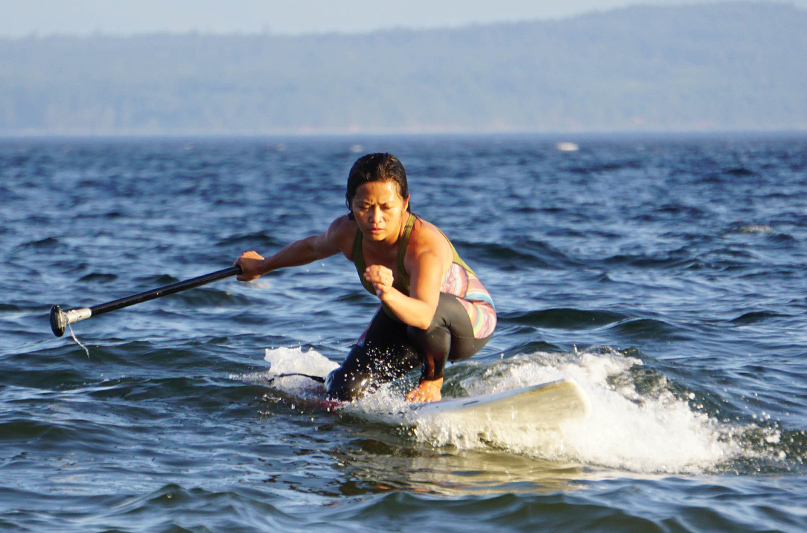
For those near Seattle, Casey recommends some local outfits. The Northwest Outdoor Center on Lake Union offers SUPs, kayaks, and paddling gear, as well as drysuit and wetsuit rentals. Urban Surf is another Lake Union option; maybe you’ve seen the crowd at Urban Surf on a sunny day at Gasworks. This extensive surf shop rents 11’, 10’6”, and 12’6” boards. If you have one you’re thinking about purchasing, Urban Surf also allows up to two demos towards the purchase of a new, full-priced SUP. Fisheries Supply Co. is also a mainstay.
From the Eastside? Check out Perfect Wave for rentals and lessons. They even offer Doggie SUP lessons for you and your pup! Northwest Paddle Surfers at Juanita Beach Park also offers lesson, rentals, and PaddleFlow Yoga. Try out their eight-person SUP if you’re feeling bold.
Half of life is accessories. Stand-up paddling is no different. As far as paddles go, you can’t go wrong with a carbon fiber make. They’re light and durable. Why add extra weight where it’s not needed? A dihedral blade splits the water in two directions, similar to that of a pointed bow. This combination will reduce stress on both your arms and wrists. Composite, aluminum, and fiberglass shafts are also common paddle types. Choose between adjustable or stationary paddles based on your needs.
Every paddler must have a lifejacket on board. If not worn, it must be attached somewhere to your board. Consider getting a lifejacket that allows a lot of arm rotation; this way you can wear it without much restriction. Life vests with CO2 cartridges are great for more experienced or racing paddlers. A sound-producing device such as a whistle, and navigation lights such as a flashlight or headlamp are also required while on board.
We’ve established that SUPs are a lot like surfboards, so why not continue the trend with a leash? Whether it be an ankle leash or one that ties around your waist, a leash could be your savior, especially in rough waters or SUP surfing.
A communication device could make all the difference in an emergency. A waterproof phone, VHF radio, or anything that can contact shore will work. And lastly, it’s often much colder on the water than shore. If you’re not in a wetsuit, it’s helpful to bring along quick-dry, high-visibility layers to maintain a comfortable body temperature. Tie down a drybag to store these layers. Additionally, booties for the Sound can save your feet from nasty barnacle cuts as well as keep your feet warm, and gloves can also be handy on our infamous overcast days.
Whether you’re stand up paddling, kayaking, surfing, or aboard any other personal watercraft (PWC), it’s important to understand and comply with recreational boating laws and rules to maintain a safe boating environment. Failure to do so and you’re not only putting yourself at risk but are creating a hazardous environment for all.
SUPs can go almost anywhere, but that doesn’t mean paddling up to the moored vessel across the bay to say hi is a good idea. Be courteous of your fellow seafarers and respect their privacy; unless they’re offering margaritas, in that case, climb aboard!
Be smart. When surfing breaks or paddling rivers, know your skill level and leave some space between you and other paddlers. It’s not fun when boards, whether they’re inflatable or hard, hit at full-speed.
Know thy weather. It’s you, your board, and your paddle, and that’s about it, which means you’re at the mercy of the seas. SUPs can’t combat the elements like larger vessels. Checking the weather and your tide chart before a day on the water is much advised.
Now for the fun stuff: where to launch! We’re lucky to have some of the most incredible waterways here in the Pacific Northwest with so many launch sites, it feels impossible to visit them all. Luckily, we’ve done everything but put the SUP in the water for you in our previous issues. If you have seen our May issue, then you’ve discovered the gold mine that is British Columbia’s extensive marine parks locations in our B.C. Parks Guide. For marine parks and launch sites in Washington State, navigate to our April issue guide!
Hidden launch sites, often concealed at streets’ ends offer access to locations not covered in our guides. To find a launch site near you, or to discover a full list of sites in your region – the popular, the unique and the obscure – check out the interactive map at paddling.com. You’ll find sites you never knew existed! So, here’s to a competitive race season, sunny days, and riding the waves. Happy paddling!
